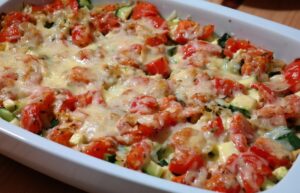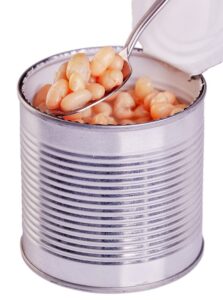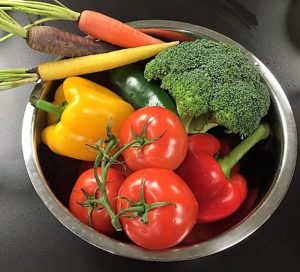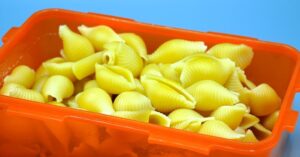 Winter nights are filled with many activities from sports and 4-H meetings to after school clubs. Finding time to plan and prepare dinner can be a challenge. However, having a few tricks in the pantry to make a quick casserole for dinner or even prepare them on the weekends and freezing them will save time on those busy weeknights.
Winter nights are filled with many activities from sports and 4-H meetings to after school clubs. Finding time to plan and prepare dinner can be a challenge. However, having a few tricks in the pantry to make a quick casserole for dinner or even prepare them on the weekends and freezing them will save time on those busy weeknights.
Calling all family members to help choose, chop, tear, and mix or layer ingredients in these tasty and nourishing dishes.
Basics Ingredients for a Casserole
There are five basic ingredients to consider when making casseroles.
-
Protein

Choose one or a combination of proteins. Needed to balance your energy to prevent the quick crash after dinner.
- 8 ounces cooked chicken, turkey, lean beef, fish, or shellfish
- 2 cups cooked lentils, beans, or split peas
- 12 ounces Tofu
-
Vegetables

They provide color, flavor and texture to the casserole. So choose a variety of vegetables.
- 2 to 3 cups sliced, chopped, or diced vegetables
- Select fresh, frozen or canned
-
Grain or Noodles

Choose either cooked pasta or grain. These items provide carbohydrates for quick energy and is a comfort food.
- 4 cups cooked pasta
- 2 cups cooked rice, barley, or quinoa
-
Sauce

Next the sauce helps bring the dish together and provides the moisture needed for baking.
- 1 ½ to 2 cups canned soup
- 1 can (16 ounces) diced tomatoes, pasta sauce, or enchilada sauce
- Homemade white, cream or cheese sauce
-
Toppings
Finally, toppings provide the eye appeal. Choose one or try a variety to create something new.
- ½ cup breadcrumbs, shredded low-fat cheese, crushed cornflakes, or corn chips
- 2 tablespoons chopped herbs such as parsley, cilantro, or green onion
Find this casserole making guide created by CSU Extension Family and Consumer Science Specialists.
Finding Recipes
 Casserole recipes can be found in many places from My Plate to Food Smart Colorado. You can even find some recipes on packages of pasta or cans of soups. Some of my favorite recipes for casseroles have been passed down through the family as easy ways my mom could prepare a hot dinner while we kids were doing homework.
Casserole recipes can be found in many places from My Plate to Food Smart Colorado. You can even find some recipes on packages of pasta or cans of soups. Some of my favorite recipes for casseroles have been passed down through the family as easy ways my mom could prepare a hot dinner while we kids were doing homework.
Look for recipes that have:
- Foods from multiple food groups (fruits, vegetable, protein, grain, and milk)
- Fill half your plate with fruits and vegetables
- Include whole grains such as brown rice, whole-wheat bread, or oatmeal
- Contain a lean protein such as legumes, beans, skinless chicken, or lean cuts of meat
- Incorporate a non-fat or low-fat dairy product or fortified nondairy option. Or serve with a calcium fortified beverage
Casseroles can be made in smaller pans and frozen. They can be put in the refrigerator to thaw the night before you want to cook them.


I have always enjoyed casseroles anytime during the year! Great way to also use leftovers !
This is so handy! Thanks, Carla. We just made our favorite lazy casserole-type dinner last night:
Preheat oven to 425
1lb Fresh cherry tomatoes (whole)
1 12 oz. rope sausage (sliced into rounds/chunks) like Hillshire Farms Beef Kielbasa
1 large onion roughly chopped into large chunks
4-10 whole garlic cloves (depending on how much you love garlic!)
1 block feta cheese (keep whole)
1-2 tablespoons olive oil
Place the feta block whole in a large glass baking dish with a little olive oil on top. Toss the veggies and sausage in ~1 tablespoon olive oil. Spread Veggie/sausage mixture over the feta and bake for about 25-30 minutes uncovered. Stir the veggies/sausage mixture at least once or twice during the bake to tuck browning bits into the juices–try to leave the feta block whole. When the onions seem soft and the tomatoes have burst, pull out and mix the whole thing up. Makes an incredibly tasty and satisfying sauce for noodles or we like to cook a spaghetti squash at the same time and serve it over that!
After years of not preparing casseroles, I have come to appreciate them again. In addition to helping me prepare meals for the week on the weekend, they are prefect for feeding family on both ends of the age spectrum (1-96 years) who have difficulty chewing some foods.
Same. Really getting into the ease of cooking a single dish and breaking it up for several meals over the week.